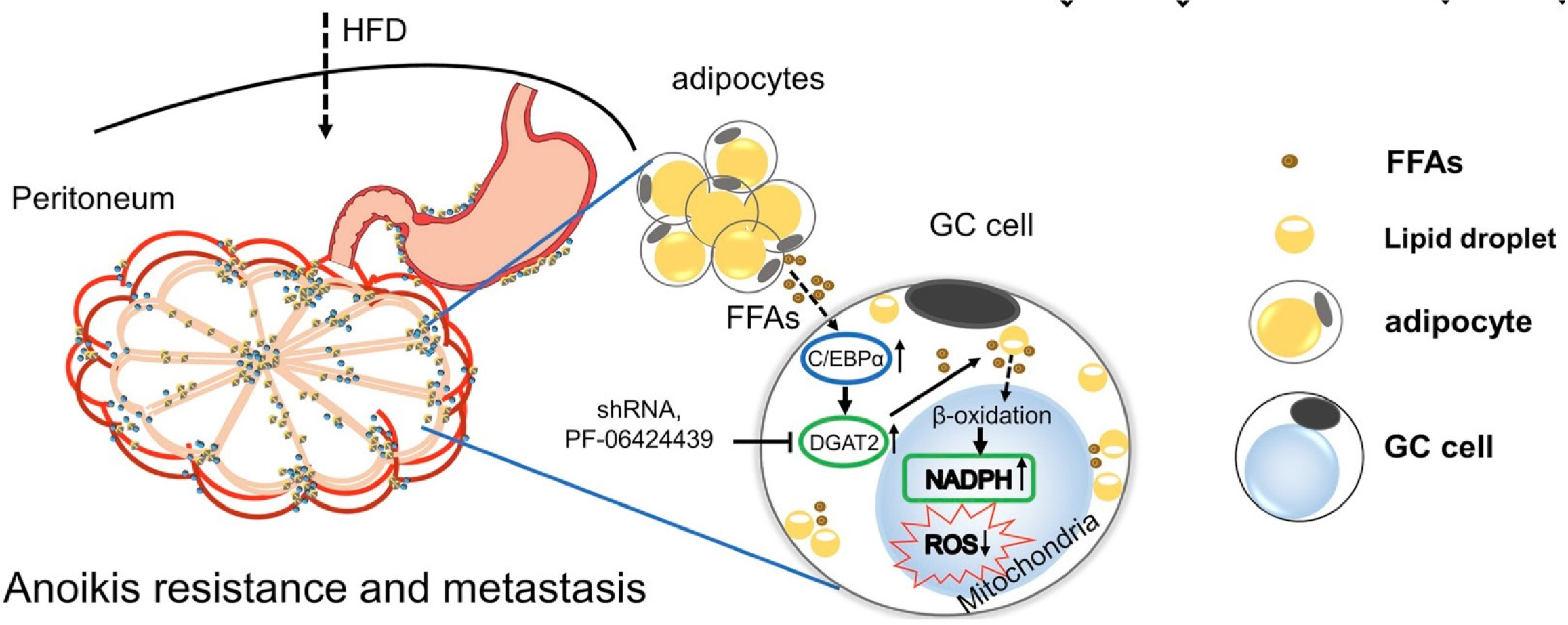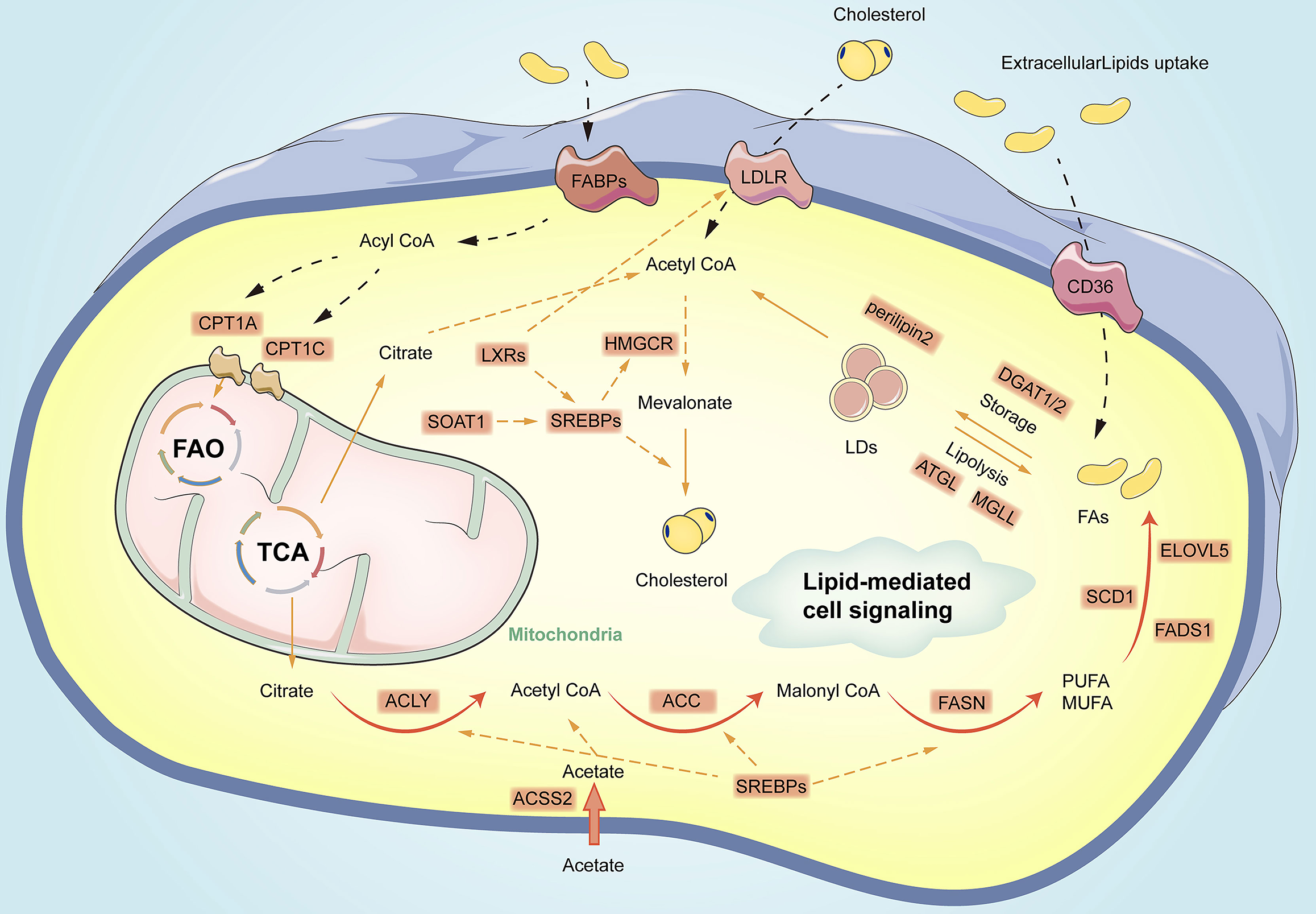Copyright
©The Author(s) 2025.
World J Gastrointest Oncol. Aug 15, 2025; 17(8): 106842
Published online Aug 15, 2025. doi: 10.4251/wjgo.v17.i8.106842
Published online Aug 15, 2025. doi: 10.4251/wjgo.v17.i8.106842
Figure 1 Schematic representation of the role of lipids in gastric cancer cell proliferation and metastasis[12].
A high-fat diet (HFD) promotes lipid accumulation in adipocytes, releasing free fatty acids (FFAs) that are taken up by gastric cancer (GC) cells. FFAs enhance lipid droplet formation via diacylglycerol acyltransferase-2 (DGAT2), regulated by CCAAT/enhancer binding protein beta (C/EBPb). Mitochondrial β-oxidation of FFAs increases NADPH and reactive oxygen species, promoting anoikis resistance and metastatic potential. Citation: Li S, Wu T, Lu YX, Wang JX, Yu FH, Yang MZ, Huang YJ, Li ZJ, Wang SL, Huang L, Lu L, Tian T. Obesity promotes gastric cancer metastasis via diacylglycerol acyltransferase 2-dependent lipid droplets accumulation and redox homeostasis. Redox Biol 2020; 36: 101596. Copyright© The Authors 2020. Published by Elsevier. The figure under the CC BY-NC-ND 4.0 License, which permits reuse with attribution, for non-commercial purposes, without derivatives (https://creativecommons.org/Licenses/by-nc-nd/4.0/). ROS: Reactive oxygen species; shRNA: Short hairpin RNA.
Figure 2 Schematic representation of fatty acid metabolism reprogramming in gastric cancer cells[39].
The diagram highlights lipid uptake, synthesis, storage, and breakdown, along with key enzymes and pathways involved in lipid-mediated cell signaling and energy production. Citation: Cui MY, Yi X, Zhu DX, Wu J. The Role of Lipid Metabolism in Gastric Cancer. Front Oncol 2022; 12: 916661. Copyright© The Authors 2022. Published by Frontiers Media S.A. This is an open-access article distributed under the terms of the Creative Commons Attribution License (CC BY). The use, distribution or reproduction in other forums is permitted, provided the original author(s) and the copyright owner(s) are credited and that the original publication in this journal is cited, in accordance with accepted academic practice. No use, distribution or reproduction is permitted which does not comply with these terms (https://creativecommons.org/Licenses/by-nc-nd/4.0/). ACC: Acetyl-CoA carboxylase; ACLY: ATP-citrate lyase; ATGL: Adipose triglyceride lipase; ACSS2: Acetyl-CoA synthetase 2; CPT1A: Carnitine palmitoyltransferase 1A; DGAT1/2: Diacylglycerol acyltransferase 1/2; ELOVL5: Elongation of very long-chain fatty acids protein 5; FAs: Fatty acids; FABPs: Fatty acid binding proteins; FADS1: Fatty acid desaturase 1; FAO: Fatty acid oxidase; FASN: Fatty acid synthase; HMGCR: 3-hydroxy-3-methylglutaryl-coenzyme A reductase; LDLR: Low-density lipoprotein receptor; LDs: Lactate dehydrogenase; LXRs: Liver X receptors; MGLL: Monoacylglycerol esterase; MUFA: Monounsaturated fatty acid; PUFA: Polyunsaturated fatty acid; SCD1: Stearoyl-CoA desaturase 1; SOAT1: Sterol O-acyltransferases 1; SREBPs: Sterol regulatory element-binding proteins; TCA: Trichloroacetic acid.
- Citation: Amir M, Bakht D, Bokhari SFH, Yousaf R, Iqbal A, Nazir H, Waleed M, Naqvi MZ, Tahir M, Dost W. Lipid metabolism-related genes in gastric cancer: Exploring oncogenic pathways. World J Gastrointest Oncol 2025; 17(8): 106842
- URL: https://www.wjgnet.com/1948-5204/full/v17/i8/106842.htm
- DOI: https://dx.doi.org/10.4251/wjgo.v17.i8.106842










